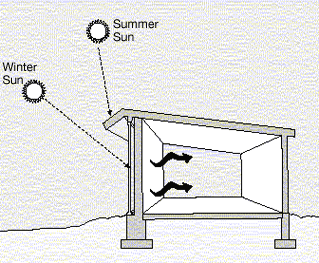However, the effects of different climates means that people need to position and install their windows differently to take advantage of solar windows' various properties.
 |
| Shaded windows keep the heat out in warmer climates. (Photo credit: Wikipedia) |
In hot and sunny climates, glazed windows should be installed towards the south of the house.
This allows the windows to collect heat when the sun is low in the sky during the day. That means the house won't overheat by allowing the sun's rays into the house during peak hours.
You can also use a number of shielding devices such as awnings or overhangs to prevent overheating during summer.
Other windows in the house can still be installed, but they should have a shade or glaze installed so they let less light into the house. Having north facing windows in a hot and sunny climate can also lead to overheating.
2. Passive Solar Windows for Cool Climates
 |
| Passive solar design using an unvented trombe wall and summer shading (Photo credit: Wikipedia) |
A trombe wall is a big wall, usually painted black, which allows you to absorb heat into the house without heat leaking out.
The main concern with using a big window is that while the sun's rays can come into the home and heat up the air, the glass conducts heat so well that it can all escape back through the glass.
The trombe wall solves this issue by trapping the heated air between the glass and the trombe wall, then circulating it into the house before the heat has a chance to escape through the glass.
The greenhouse approach uses similar technology to a greenhouse to keep heated air in the house. You use a large number of windows to let the sun's rays into your house, then you use a controlled timer to circulate the air within your house in a way that optimizes the heat and reduces the amount of heat that escapes through the same glass windows that let the heat in.
Are Passive Solar Windows for You?
Passive solar windows can work for both hot and cold climates, whether there's a lot of sun or just a little bit of sun.
To determine whether or not your home qualifies for passive solar windows, talk to an environmental contractor in your area. Make sure you get several different opinions to get a definitive sense of whether or not it's worth the investment, as they can be pricey - but they can also save you a lot - especially on heating bills - in the long run.
Thank you so much for sharing this great blog.
ReplyDeleteWindows For House
Sliding Window Replacement